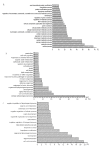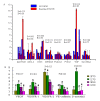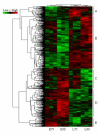Detection of differentially expressed genes between Erhualian and Large White placentas on day 75 and 90 of gestation
- PMID: 19630995
- PMCID: PMC2724418
- DOI: 10.1186/1471-2164-10-337
Detection of differentially expressed genes between Erhualian and Large White placentas on day 75 and 90 of gestation
Abstract
Background: Placental efficiency is strongly associated with litter size, fetal weight and prenatal mortality. Together with its rapid growth during late gestation, the Large White pig breed shows a significant increase in placental size and weight, but this does not occur in the highly prolific Chinese pig breeds. To understand the molecular basis of placental development during late gestation in Chinese indigenous and Western breeds with different placental efficiency, female placental samples were collected from six pregnant Erhualian gilts at gestation day 75 (E75) and day 90 (E90) and from six pregnant Large White gilts at gestation day 75 (L75) and day 90 (L90). Two female placentas from one sow were used to extract RNA and then pooled in equal volumes. Twelve pooled samples were hybridized to the porcine Affymetrix GeneChip.
Results: A total of 226 and 577 transcripts were detected that were differentially expressed between E75 and L75 and between E90 and L90 (p < 0.01, q < 0.2), respectively. Gene Ontology (GO) analysis revealed that these genes belong to the class of genes that participate in angiogenesis and development. Real-time RT-PCR confirmed the differential expression of eight selected genes. Significant differential expression of five genes in the VEGF pathway was also detected between the breeds. A search of chromosomal location revealed that 44 differentially expressed genes located to QTL regions related to reproduction. Differential expression of six candidate imprinted genes was also confirmed. Three of the six genes (PLAGL1, DIRAS3, and SLC38A4) showed monoallelic expression in the porcine placenta.
Conclusion: Our study detected many genes that showed differential expression between placentas of two divergent breed of pigs, and confirmed the imprinting of three genes. These findings help to elucidate the genetic control of placental efficiency and improve the understanding of placental development.
Figures




Similar articles
-
Differential gene expression in the endometrium on gestation day 12 provides insight into sow prolificacy.BMC Genomics. 2013 Jan 22;14:45. doi: 10.1186/1471-2164-14-45. BMC Genomics. 2013. PMID: 23339594 Free PMC article.
-
Microarray profiling for differential gene expression in PMSG-hCG stimulated preovulatory ovarian follicles of Chinese Taihu and Large White sows.BMC Genomics. 2011 Feb 16;12:111. doi: 10.1186/1471-2164-12-111. BMC Genomics. 2011. PMID: 21324170 Free PMC article.
-
Characterization of conserved and nonconserved imprinted genes in swine.Biol Reprod. 2009 Nov;81(5):906-20. doi: 10.1095/biolreprod.109.078139. Epub 2009 Jul 1. Biol Reprod. 2009. PMID: 19571260 Free PMC article.
-
Embryonic and fetal development in different genotypes in pigs.J Reprod Fertil Suppl. 1997;52:165-76. J Reprod Fertil Suppl. 1997. PMID: 9602727 Review.
-
Current approaches and developments in transcript profiling of the human placenta.Hum Reprod Update. 2020 Nov 1;26(6):799-840. doi: 10.1093/humupd/dmaa028. Hum Reprod Update. 2020. PMID: 33043357 Free PMC article. Review.
Cited by
-
Expression of genes involved in progesterone receptor paracrine signaling and their effect on litter size in pigs.J Anim Sci Biotechnol. 2016 May 25;7:31. doi: 10.1186/s40104-016-0090-z. eCollection 2016. J Anim Sci Biotechnol. 2016. PMID: 27231548 Free PMC article.
-
The identification of differentially expressed genes between extremes of placental efficiency in maternal line gilts on day 95 of gestation.BMC Genomics. 2019 Mar 29;20(1):254. doi: 10.1186/s12864-019-5626-0. BMC Genomics. 2019. PMID: 30925895 Free PMC article.
-
Glucocorticoid receptor is involved in the breed-dependent transcriptional regulation of mtDNA- and nuclear-encoded mitochondria genes in the liver of newborn piglets.BMC Vet Res. 2013 Apr 26;9:87. doi: 10.1186/1746-6148-9-87. BMC Vet Res. 2013. PMID: 23618392 Free PMC article.
-
Endometrial gene expression profile of pregnant sows with extreme phenotypes for reproductive efficiency.Sci Rep. 2015 Oct 5;5:14416. doi: 10.1038/srep14416. Sci Rep. 2015. PMID: 26435523 Free PMC article.
-
Hypoxia-inducible factor 1 signaling drives placental aging and can provoke preterm labor.Elife. 2023 Aug 23;12:RP85597. doi: 10.7554/eLife.85597. Elife. 2023. PMID: 37610425 Free PMC article.
References
-
- Molteni RA, Stys SJ, Battaglia FC. Relationship of fetal and placental weight in human beings: fetal/placental weight ratios at various gestational ages and birth weight distributions. J Reprod Med. 1978;21:327–34. - PubMed
-
- Carter AM. Factors affecting gas transfer across the placenta and the oxygen supply to the fetus. J Dev Physio. 1989;12:305e22. - PubMed
Publication types
MeSH terms
LinkOut - more resources
Full Text Sources
Molecular Biology Databases

